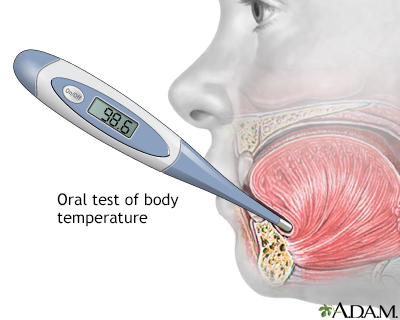Pregnancy SmartSiteTM
Query fever DefinitionQ fever is an infectious disease caused by bacteria spread by domestic and wild animals and ticks. CausesQ fever is caused by the bacteria Coxiella burnetii, which live in domestic animals such as cattle, sheep, goats, birds, and cats. Some wild animals and ticks also carry these bacteria. You can get Q fever by drinking raw (unpasteurized) milk, or after breathing in dust or droplets in the air that are contaminated with infected animal feces, blood, or birth products. People at risk for infection include slaughterhouse workers, veterinarians, researchers, food processors, and sheep and cattle workers. Men are infected more often than women. Most people who get Q fever are age 30 to 70 years. In rare cases, the disease affects children, especially those who live on a farm. In infected children younger than 3 years old, Q fever is usually noticed while looking for the cause of pneumonia. SymptomsSymptoms usually develop 2 to 3 weeks after coming in contact with the bacteria. This time is called the incubation period. Most people have no symptoms. Others may have moderate symptoms similar to the flu. If symptoms occur, they may last for several weeks. Common symptoms may include:
Other symptoms that may develop include:
Exams and TestsA physical exam may reveal abnormal sounds (crackles) in the lungs or an enlarged liver or spleen. In the late stages of the disease, a heart murmur may be heard. Tests that may be done include:
TreatmentTreatment with antibiotics can shorten the length of the illness. Antibiotics that are commonly used include tetracycline and doxycycline. Pregnant women or children who still have any baby teeth should avoid tetracycline by mouth because it can permanently discolor growing teeth. Outlook (Prognosis)Most people get better with treatment. However, complications can be very serious and sometimes even life threatening. Q fever should always be treated if it causes symptoms. Possible ComplicationsIn rare cases, Q fever causes a heart infection (endocarditis) that can lead to severe symptoms or even death if untreated. Other complications can include:
When to Contact a Medical ProfessionalContact your health care provider if you develop symptoms of Q fever. Also contact your provider if you have been treated for Q fever and symptoms return or new symptoms develop. PreventionPasteurization of milk destroys the bacteria that cause early Q fever. Domestic animals should be inspected for signs of Q fever if people exposed to them have developed symptoms of the disease. ReferencesFournier P-E, Raoult D. Rickettsial infectionss. In: Goldman L, Cooney KA, eds. Goldman-Cecil Medicine. 27th ed. Philadelphia, PA: Elsevier; 2024:chap 302. Hartzell JD, Marrie TJ, Raoult D. Coxiella burnetti (Q fever). In: Bennett JE, Dolin R, Blaser MJ, eds. Mandell, Douglas, and Bennett's Principles and Practice of Infectious Diseases. 9th ed. Philadelphia, PA: Elsevier; 2020:chap 188. | ||
| ||
Review Date: 8/29/2024 Reviewed By: Jatin M. Vyas, MD, PhD, Roy and Diana Vagelos Professor in Medicine, Columbia University Vagelos College of Physicians and Surgeons, Division of Infectious Diseases, Department of Medicine, New York, NY. Also reviewed by David C. Dugdale, MD, Medical Director, Brenda Conaway, Editorial Director, and the A.D.A.M. Editorial team. View References The information provided herein should not be used during any medical emergency or for the diagnosis or treatment of any medical condition. A licensed medical professional should be consulted for diagnosis and treatment of any and all medical conditions. Links to other sites are provided for information only -- they do not constitute endorsements of those other sites. No warranty of any kind, either expressed or implied, is made as to the accuracy, reliability, timeliness, or correctness of any translations made by a third-party service of the information provided herein into any other language. © 1997- A.D.A.M., a business unit of Ebix, Inc. Any duplication or distribution of the information contained herein is strictly prohibited. | ||


 Temperature measur...
Temperature measur...
